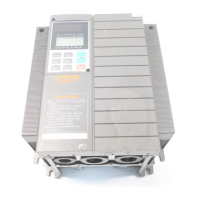9-58
E20 Terminal [Y1] Function
E27 Terminal [30A/B/C] Function (Relay output)
E20 and E27 assign output signals (listed on the next page) to general-purpose,
programmable output terminals [Y1] and [30A/B/C]. These function codes can also switch
the logic system between normal and negative to define the property of those output terminals
so that the inverter logic can interpret either the ON or OFF status of each terminal as active.
The factory default settings are "Active ON."
Terminal [Y1] is a transistor output and terminals [30A/B/C] are relay contact outputs. In
normal logic, if an alarm occurs, the relay will be energized so that [30A] and [30C] will be
closed, and [30B] and [30C] opened. In negative logic, the relay will be deenergized so that
[30A] and [30C] will be opened, and [30B] and [30C] closed. This may be useful for the
implementation of failsafe power systems.
• When a negative logic is employed, all output signals are active (e.g. an alarm
would be recognized) while the inverter is powered OFF. To avoid causing
system malfunctions by this, interlock these signals to keep them ON using an
external power supply. Furthermore, the validity of these output signals is not
guaranteed for approximately 1.5 seconds after power-on, so introduce such a
mechanism that masks them during the transient period.
• Terminals [30A/B/C] use mechanical contacts that cannot stand frequent
ON/OFF switching. Where frequent ON/OFF switching is anticipated (for
example, limiting a current by using signals subjected to inverter output limit
control such as switching to commercial power line), use transistor output [Y1]
instead. The service life of a relay is approximately 200,000 times if it is
switched on and off at one-second intervals.

